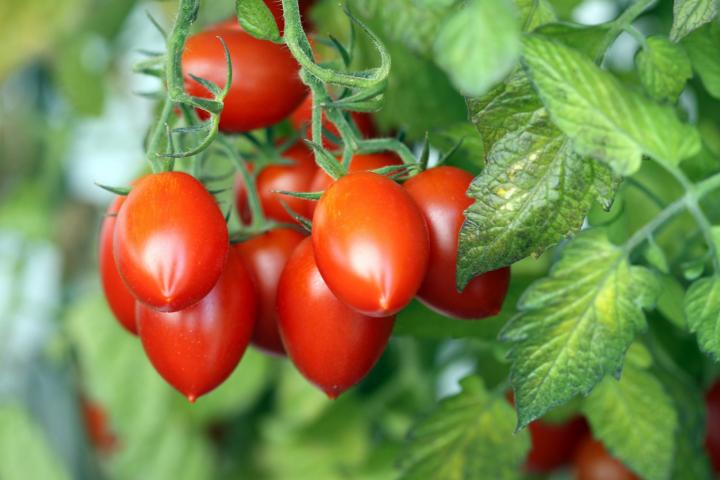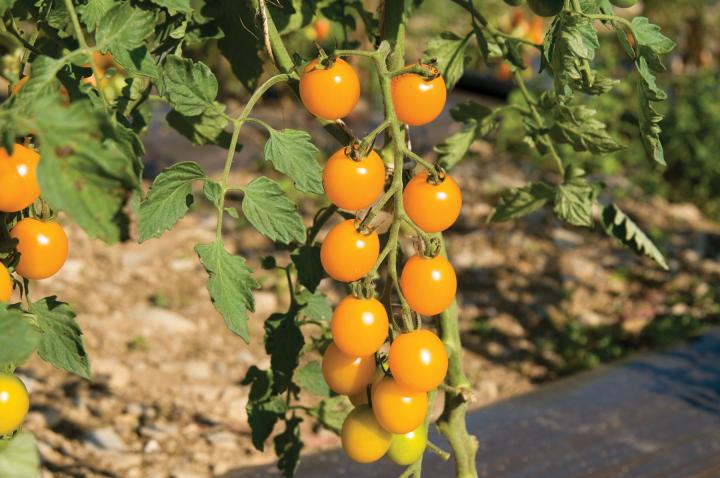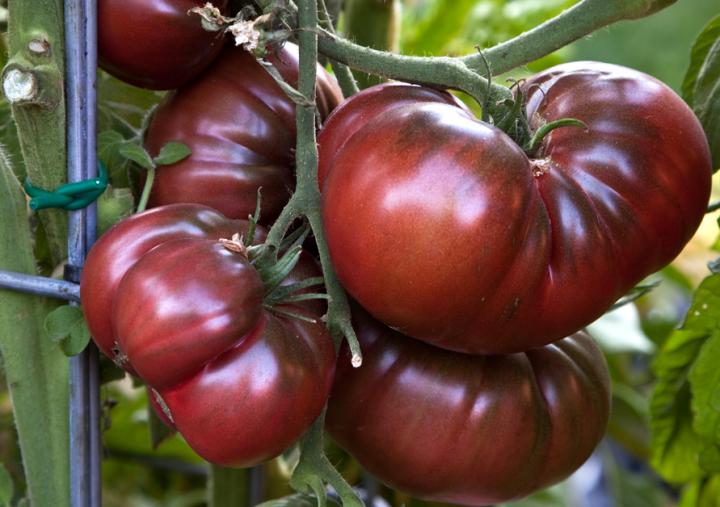
The first job is deciding what to grow, and with at least 10,000 different varieties of tomato, there’s certainly plenty to choose from, including cherry tomatoes, paste types, varieties with standard round fruits, and chunky beefsteak tomatoes.
Whatever you grow, they’ll fall into one of two categories: ‘bush’ tomatoes, sometimes called determinate tomatoes, which grow to around 3 feet (1m) tall, and ‘vining’ tomatoes, also called indeterminate or ‘cordon’ tomatoes, which continue growing to produce fruits on one long stem. Learn more about the difference between determinate and indeterminate tomatoes.
Do you only have a hanging basket? Hey, that’s no problem—there are compact tomatoes for this situation, too.
- Determinate tomatoes, better known as bush varieties, grow 2 to 3 feet tall. These varieties tend to provide numerous ripe tomatoes at one time. They do not put on much leaf growth after setting fruit and tend to fruit for a (relatively) brief period of time. They are generally productive earlier than the vining varieties and not in the latter part of the growing season. Determinate tomatoes do not require staking or caging. These plants are ideal for containers and small spaces. Most paste tomatoes are determinate, which works well for making sauce and canning. Because they produce determinate tomatoes at the same time, they are a good selection for canning.
- Indeterminate tomatoes, better known as vining varieties, produce the largest types of mid- to late-season slicing tomatoes all summer and until the first frost. Because indeterminates experience more leaf growth, their production tends to be spread more evenly throughout the season. Indeterminate tomatoes need staking. They are ideal in large gardeners. Most beefsteak and cherry tomatoes are indeterminate.
Tomatoes come in a wide range of flavors, colors, and sizes. The choice also depends on how you use this versatile fruit in the kitchen. Cherry tomatoes are great for salads. Beefsteaks are great for sandwiches.
Romas are not usually eaten fresh out of hand but are perfect for sauces and ketchup. See our separate Guide to Growing Roma Tomatoes.
Also, tomatoes can be susceptible to pests and diseases. To avoid problems, choose disease-resistant cultivars whenever possible.
Early Varieties (fewer than 70 days to harvest)
Early-maturing cultivars such as ‘Early Girl’ may be slightly less flavorful but will produce fruit 2 to 3 weeks earlier than mid or late-season cultivars.
- ‘Early Cascade’: indeterminate trailing plant, fruit in clusters; disease-resistant
- ‘Early Girl’: indeterminate, meaty fruit; produces through the summer
Mid-season Varieties (70 to 80 days to harvest)
- ‘Floramerica’: determinate; disease-resistant; firm, deep red flesh, strong plant
- ‘Fantastic’: indeterminate; disease- and crack-resistant; meaty, rich flavor, heavy yields
Late-season Varieties (80 days or more to harvest)
- ‘Amish Paste’: indeterminate; heirloom; large plum tomatoes, acorn-shaped fruit; juicy, excellent for sauce.
- ‘Brandywine’: indeterminate; heirloom; beefsteak with perfect acid-sweet combination; many variants are available
- ‘Tomato, Roma VF’: determinate; compact Roma tomatoes; resistant to wilts. Meaty interiors and few seeds; heavy-yielding; good for paste and canning.

Credit: Ben185/Getty
- ‘Sun Gold’: 57 days to maturity; indeterminate; resistant to Fusarium wilt and tobacco mosaic virus; bright tangerine-orange color on grapelike trusses; intensely sweet taste
- ‘Matt’s Wild Cherry’: indeterminate, disease-resistant (including blight)
- ‘Yellow Mini (F1)’: 57 days to maturity; indeterminate; sweet, juicy favor; compared with other cherry tomatoes, Yellow Mini resists the splitting that is caused by too much rain or inconsistent watering; high resistance to tobacco mosaic virus.

Credit: Johnny Seeds.
Large Tomatoes
- Beefsteak, Beefmaster, Ponderosa, and Oxheart are noted for their large fruit. However, these larger fruited types often are more susceptible to diseases and skin cracking.

Credit: Park Seed.
Learn how to choose tomato varieties.




